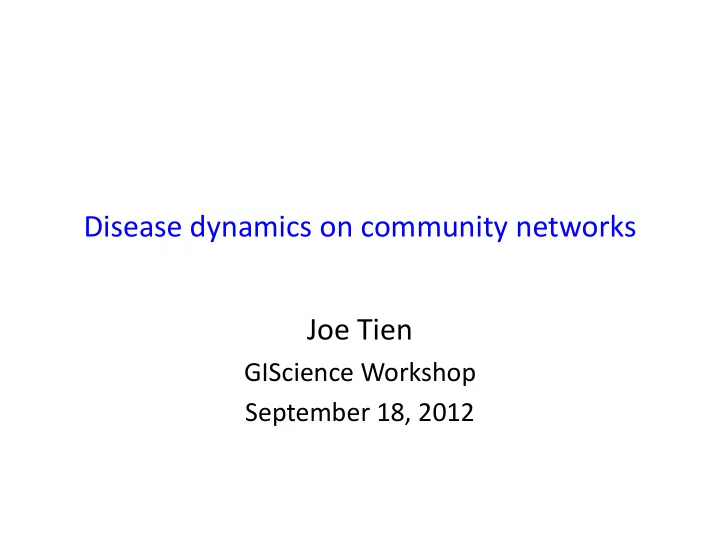

Disease dynamics on community networks Joe Tien GIScience Workshop September 18, 2012
Collaborators • Zhisheng Shuai • Pauline van den Driessche • Marisa Eisenberg
John Snow and the Broad Street Pump
Geographic analysis of cholera spatial spread Journal of Geographic Analysis 1: 59-75. 1969.
Present day cholera: Haiti El Tor Ogawa (same strain as found in SE Asia) • Start of the outbreak – Artibonite Valley • Official stats (Haitian Ministry of Health) as of April 10, 2012: • – 534,647 cases – 7,091 deaths Cholera ward, Hopital Albert Schweitzer Source: MSPP
Outline • Theoretical results – Ability of disease to invade a community network – Network risk and patch risk – Clustering of disease hot spots • Haiti cholera • Opportunities to merge theory and data
Community networks
Model Assumptions • Patch dynamics correspond to an “SIWR” system. • The network is strongly connected by the movement of water. • Infected people are too sick to move. • All disease transmission is waterborne.
Patch dynamics µ S µ I µ R γ I µ S I R b W SW α I W ξ W W - pathogen concentration in water reservoir
Invasibility and the basic reproduction number • Number of secondary infections created by single infected individual in otherwise susceptible population • Rate of new infections × length of infectiousness • R 0 > 1 disease can invade
Defining the basic reproduction number • Second generation matrix approach (Diekmann, Heesterbeek, and Metz (1990); van den Driessche and Watmough (2002)).
Network R 0 • Interplay of two time scales: δ i -- pathogen decay rate in the water for patch i d W – movement rate of water What happens in the limits of fast / slow water movement?
R 0 and time scales of movement / decay Fast decay limit: Fast movement / slow decay limit: Scaled time: G W approaches the singular matrix L
Laurent series expansion for R 0 Langenhop (1971): Laurent series for perturbed singular matrices • For a given network, these terms can be computed explicitly • X -1 – involves the rooted spanning trees of the network • X _0 – involves a fundamental matrix of an associated Markov process • These terms have natural biological interpretations…
R 0 and spanning trees • Weighted average according to the rooted spanning trees u i (network risk) • Patch risks q i r i / (m i + γ i + d i ) – “Transmission” -- “Average pathogen lifetime” •
Rooted spanning trees: “rivers” • Network risk increases by a factor of a/b each step downstream • Worst place for disease hot spot -- downstream
Rooted spanning trees: balanced graphs • Balanced graph – the net outflow equals net inflow for every vertex - Need not be symmetric • Identical network risk for every vertex: u i = u j for all i, j Identical R 0 in the limit of fast water movement
R 0 , bottlenecks, and clustering Interpreting next term X 0 : Impact on R 0 :
R 0 , bottlenecks, and clustering Biological interpretation: • Clustering hot spots together will increase R 0 • Worse hot spots greater impact of clustering on R 0 • Bottlenecks to mixing greater impact of clustering on R 0
R 0 , bottlenecks, and clustering
Accuracy when movement is fast
Insights when movement is slow Theorem R 0 for the domain is monotone increasing with ε . Biological significance • Moving a hot spot to a node with a larger number of spanning trees always increases R 0 • Clustering hot spots together always increases R 0
Epidemic centroid movements
Spatial models • Linking disease dynamics at the Department level • Patch models: – Patch = Department – Dynamics within each patch (e.g. SIWR) – Coupling between patches
Patch coupling via “ gravity ” λ j -- “ Force of infection ” on patch j Contribution from patch k to j: – Proportional to N j N k – Inversely proportional to distance between patches Tuite et al. 2011. Ann. Internal Med.
Gravity model: comparison with data Tuite et al. 2011. Ann. Internal Med.
Moran ’ s I • Clustering statistic: correlation according to connectivity matrix • Initial invasion period when spatial clustering is evident • Strongest clustering according to physical adjacency
Opportunities in the geosciences • Need for data • Geographic networks (e.g. river networks, habitat) – Topology – Weights • Human networks • Patch characteristics
Acknowledgements Marisa Eisenberg Hopital Albert Schweitzer Mark Guseman U.N. WASH Cluster International Organization of Migration Pauline van den Driessche NASA Tropical Rainfall Measuring Mission Zhisheng Shuai CDC USGS Ohio Water Science Center David Fisman Ashleigh Tuite National Science Foundation – EEID Program Greg Kujbida Mathematical Biosciences Institute David Earn References Junling Ma Tien JH, Earn DJD. 2010. Bull. Math. Biol . 72(6): Ian Rawson 1506-1533. Dawn Johnson Tuite et al. 2011. Annal. Int. Med . 154(9): 593-601. Renold Estimie Carrie Weinrobe Eisenberg, Shuai, Tien, van den Driessche. 2012. Julio Urruela In prep. Patrick Duigan
Recommend
More recommend